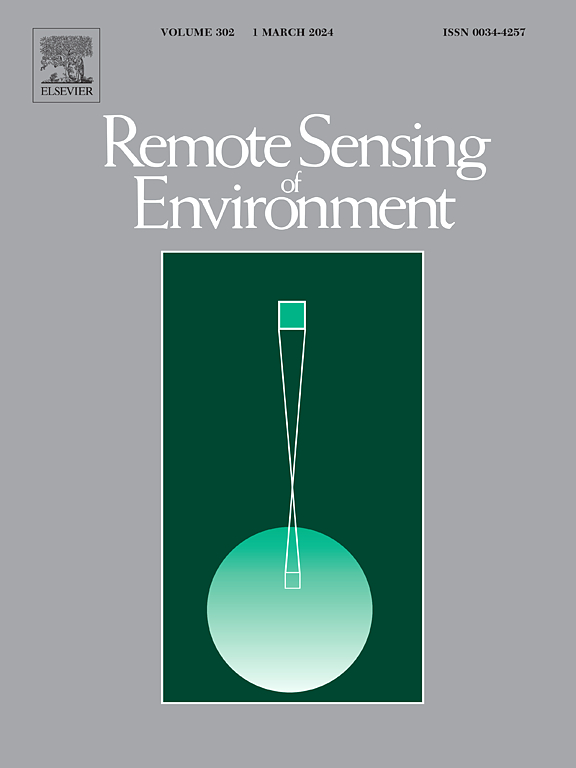Characterizing dynamics of built-up height in China from 2005 to 2020 based on GEDI, Landsat, and PALSAR data
IF 11.1
1区 地球科学
Q1 ENVIRONMENTAL SCIENCES
引用次数: 0
Abstract
The unprecedented urbanization in China has driven rapid urban and rural development in recent decades. While existing studies have extensively focused on horizontal urban expansion, research on vertical urban expansion patterns remains limited. To address this gap, this study proposed a Multi-Temporal Built-up Height estimation Network (MTBH-Net) to estimate 30-m China Multi-Temporal Built-up Height (CMTBH-30) by integrating Global Ecosystem Dynamics Investigation (GEDI), Landsat, and PALSAR data. Specifically, we introduced sample migration to generate reference built-up height data and applied the Continuous Change Detection and Classification (CCDC) disturbance feature to reduce inconsistency in unchanged built-up areas. Validation using the GEDI test set demonstrated that CMTBH-30 achieved RMSEs of 5.10 m, 5.53 m, 6.16 m, and 6.21 m for 2005, 2010, 2015, and 2020. Further validation with field-collected data yielded an RMSE of 4.54 m. Additionally, CMTBH-30 is consistent with the 3D-GIoBFP dataset, achieving RMSEs ranging from 5.34 m to 8.95 m across ten cities. Our findings reveal an increase in average built-up heights in China from 10.28 m in 2005 to 10.92 m in 2020, reflecting an upward trend in urban development. Additionally, the standard deviation of built-up heights rises from 5.16 m in 2005 to 7.71 m in 2020, indicating increased height variation nationwide. Regional analysis from 2005 to 2020 highlights notable vertical growth in newly expanded built-up areas in Macau (+14.4 m), Hong Kong (+12.3 m), and Guangdong (+12.3 m), while Qinghai (+3.8 m) and Chongqing (+3.0 m) also experienced significant growth in stable built-up areas. Heilongjiang, Jilin, Hebei, and Taiwan exhibited minimal growth. The CMTBH-30 dataset effectively captures fine-grained built-up heights, addressing the gap in multi-temporal built-up height estimation. This study provides a new dimension for urban research and is valuable for a multitude of applications such as urban planning, disaster management, and sustainable development. The CMTBH-30 dataset is available at https://data-starcloud.pcl.ac.cn/iearthdata/.
基于GEDI、Landsat和PALSAR数据的2005 - 2020年中国建成区高度变化特征
近几十年来,中国史无前例的城市化进程推动了城乡的快速发展。虽然现有的研究主要集中在城市横向扩张上,但对城市纵向扩张模式的研究仍然有限。为了解决这一问题,本研究通过整合全球生态系统动力学调查(GEDI)、Landsat和PALSAR数据,建立了一个多时相建筑高度估算网络(mthh - net)来估算30 m中国多时相建筑高度(cmthh -30)。具体而言,我们引入样本迁移来生成参考建成区高度数据,并应用连续变化检测和分类(CCDC)干扰特征来减少未改变建成区的不一致性。GEDI试验集验证表明,cmthh -30在2005年、2010年、2015年和2020年的rmse分别为5.10 m、5.53 m、6.16 m和6.21 m。通过现场收集的数据进一步验证,RMSE为4.54 m。此外,cmbh -30与3D-GIoBFP数据集一致,在10个城市中实现了5.34 ~ 8.95 m的均方根误差。我们的研究结果显示,中国的平均建筑高度从2005年的10.28米增加到2020年的10.92米,反映了城市发展的上升趋势。此外,建筑高度的标准差从2005年的5.16 m上升到2020年的7.71 m,表明全国范围内的高度变化有所增加。2005年至2020年的区域分析显示,澳门(+14.4米)、香港(+12.3米)和广东(+12.3米)的新建建成区垂直增长显著,而青海(+3.8米)和重庆(+3.0米)的稳定建成区也出现了显著增长。黑龙江、吉林、河北和台湾的增长幅度最小。cmthh -30数据集有效捕获细粒度建筑高度,解决了多时相建筑高度估计的空白。该研究为城市研究提供了一个新的维度,对城市规划、灾害管理和可持续发展等众多应用具有重要价值。cmthh -30数据集可在https://data-starcloud.pcl.ac.cn/iearthdata/上获得。
本文章由计算机程序翻译,如有差异,请以英文原文为准。
求助全文
约1分钟内获得全文
求助全文
来源期刊

Remote Sensing of Environment
环境科学-成像科学与照相技术
CiteScore
25.10
自引率
8.90%
发文量
455
审稿时长
53 days
期刊介绍:
Remote Sensing of Environment (RSE) serves the Earth observation community by disseminating results on the theory, science, applications, and technology that contribute to advancing the field of remote sensing. With a thoroughly interdisciplinary approach, RSE encompasses terrestrial, oceanic, and atmospheric sensing.
The journal emphasizes biophysical and quantitative approaches to remote sensing at local to global scales, covering a diverse range of applications and techniques.
RSE serves as a vital platform for the exchange of knowledge and advancements in the dynamic field of remote sensing.
 求助内容:
求助内容: 应助结果提醒方式:
应助结果提醒方式:


